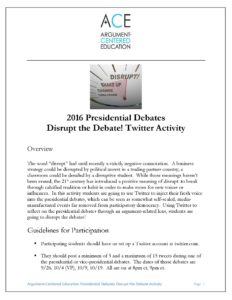
Disrupt the Debate! A Twitter Activity on the 2016 Presidential Debates
Overview
The word “disrupt” had until fairly recently a strictly negative connotation. A business strategy could be disrupted by political unrest in a trading partner country; a classroom could be derailed by a disruptive student. While those meanings haven’t been erased, the 21st century has introduced a positive meaning of disrupt: to break through calcified tradition or habit in order to make room for new voices or influences. In this activity students are going to use Twitter to inject their fresh voice into the presidential debates, which can be seen as somewhat self-sealed, media-manufactured events far removed from participatory democracy. Using Twitter to reflect on the presidential debates through an argument-related lens, students are going to disrupt the debates!
Guidelines for Participation
** Participating students should have or set up a Twitter account at twitter.com.
** They should post a minimum of 5 and a maximum of 15 tweets during one of the presidential or vice-presidential debates. The dates of those debates are 9/26, 10/4 (VP), 10/9, 10/19. All are on at 8pm ct, 9pm et.
** Teachers who have students participating should try to send an email to info@argumentcenterededucation.com noting how many students they estimate they will have participate. Teachers are welcome and encouraged to participate, too.
** All Twitter posts should include the hashtag #disruptthedebate. Participants should have this page on Twitter open during the debate so they can check to see what other student participants are tweeting about.
** All posts should be civil, constructive, and appropriate (e.g., no profanity). Expressive, passionate, pointed, born of deep conviction – that’s all fine and welcome.
Content and Coding
The Disrupt the Debate activity asks students to react to and comment on the debate in ways that come from a close look at the debate as a forum for argumentation. The questions that students should be considering throughout the debate are:
What are the candidates’ positions on the key issues?
What are their arguments for these positions?
How do they engage with the arguments of their opponent?
How well do they communicate their arguments?
As long as they are closely considering these questions, students are free to generate whatever responses and viewpoints they feel compelled by during the debate.
There are five categories of tweets that students that students should also be guided by and that should code their tweets. (The brilliant idea for coding tweets this was is property of the Chicago Public Schools Office of Civics Education and Social Science, and in particular manager Heather Van Benthuysen.)
E: Evidence
Comments on the evidence or lack of evidence used to support an argument made by one of the candidates. Fact-checking comments fall under this category.
M: Moderator
Comments on the role being played by the moderator, good orbad, or comments on an audience question or the audience’s role. Suggestions for questions or for changes in the performance of the moderator fall in this category.
R: Response
Comments on the strength of a candidate’s response or refutationof the other candidate’s arguments, or on the lack of responsiveness. Comments that suggest what a candidate could have or should have said in response to other candidate fall in this category.
S: Style
Comments on the speaking style, composure, body language, and all of the formal qualities of the speakers. Anything that pertains to the candidates themselves but that doesn’t have to do directly with their argumentation falls into this category.
W: Winning
Comments about who is winning or losing the debate, argumentation on an issue, or a specific argumentative exchange.
The code letter should come at the beginning of the tweet. For example:
R: HRC was very effective in her response to Trump’s arg that she made ISIS stronger. US winning war now against ISIS.
Participants should remember to use the hashtag #disruptthedebate on every one of their tweets.
Participants are encouraged to respond to other participants’ tweets.
Not all tweets fit within 140 characters. Disrupt the Debate allows for tweets that run on to two or (maximum) three tweets, though these longer run-ons only count as one.
Classroom Use and Assessment
Teachers are encouraged to review and possibly analyze the tweets posted to the hashtag #disruptthedebate in class subsequent to the debate.
Teachers might give students 80% credit for posting 5 – 15 tweets during the debate, as long as they use the hashtag #disruptthedebate and are coded. The remaining 20% can be given out on the basis of the quality of students’ argument-related response to the candidates’ debating, reflected by their disrupting tweets!


